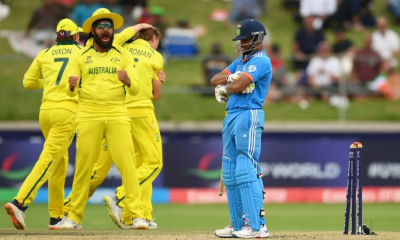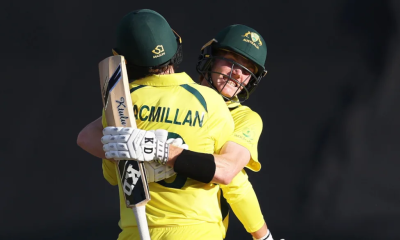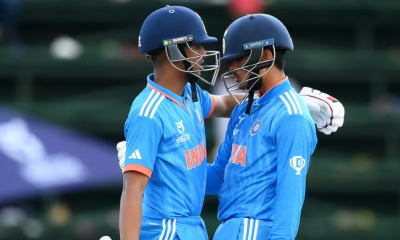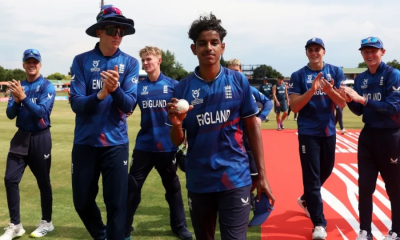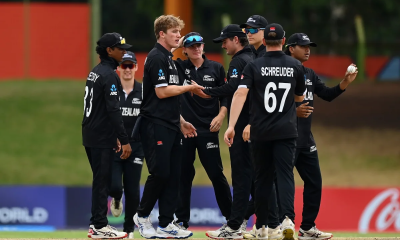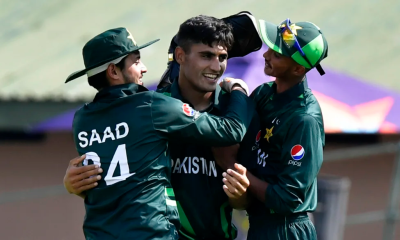Latest News
Nepal beat Afghanistan in thriller; West Indies inch past England by two wickets
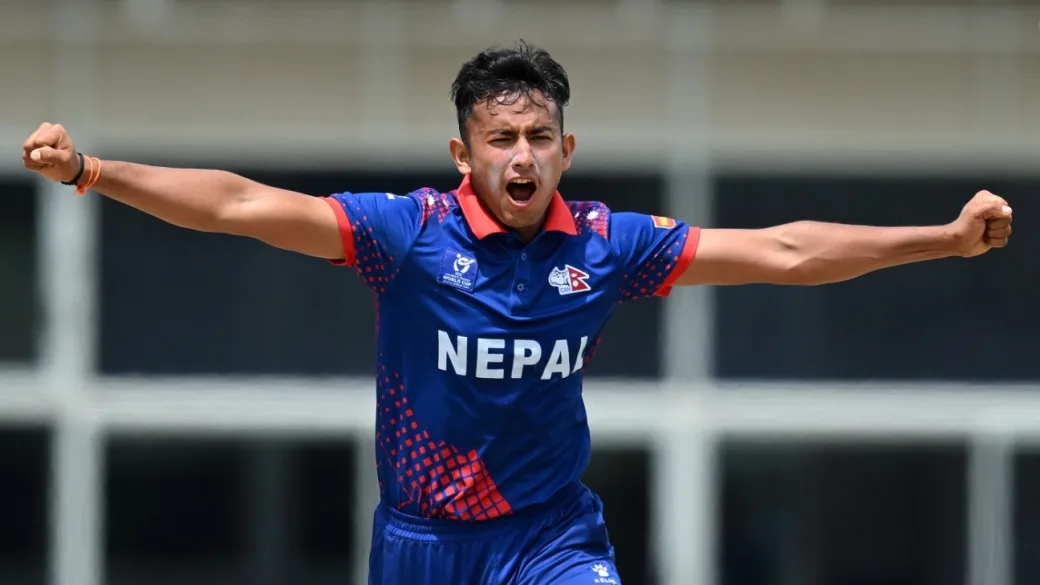
Afghanistan and Nepal had everything to play for in East London on Friday, and play they did, toe-to-toe, inch-for-inch, all the way to a thrilling finish amid gripping drama. Nepal won by one wicket in the end, and entered the Super Six stage of the men’s Under-19 World Cup at the expense of Afghanistan; but the game was, perhaps, more than just the result and the make-up of the next stage of the tournament.
Nepal seemed to have it in the bag at various stages, when first Aakash Chand was running through the Afghanistan batting, and then when Dev Khanal, the captain, was stroking his way to an 89-ball 58. But if there’s one thing Afghanistan don’t do – at any level of the game – it’s to give up. They took it deep, before Subash Bhandari, who had earlier returned 1 for 15 from 8.1 overs, poked at one outside off to the legspin of Arab Gul, got a healthy edge and sent it through a packed off-side field for four. Deal done. The celebrations were as wild as the game itself was.
The win was set up by Chand, later named Player of the Match. By the tenth over, Afghanistan were tottering at 34 for 5 after having opted to bat. Chand had four of those wickets. The fightback came courtesy Hassan Eisakhil (20) and Naseer Khan Maroofkhil (31), and then Allah Mohammad Ghazanfar (37); but all Afghanistan could put up was 145. Chand finished with 5 for 34, his fifth wicket that of Eisakhil.
Nepal’s reply started almost as shakily, with Khalil Ahmed and Faridoon Dawoodzai reducing them to 24 for 3. But a dominant Khanal and a sedate Aakash Tripathi appeared to take the game away from Afghanistan with a 49-run stand, the best of the innings.
A twist had to come, and it came in the form of Maroofkhil sending Tripathi back in the 24th over, with the target still 73 runs away. Khanal wasn’t going anywhere, though, even as a couple more wickets fell at the other end, before being felled by Ghazanfar for 58.
The total then was 127 for 7. Overs were not an issue, but Afghanistan were into Nepal’s tail. Dipak Bohora ensured it wagged enough to take Nepal to within a shot of victory, but he too fell with six runs still to get. The fielders were all around the bat at that stage, and the dot balls piled up; but somehow, in the end, Bhandari found a way out.
Brief scores:
Nepal Under 19s 149 for 9 in 44.4 overs (Dev Khanal 58, Dipak Bohara 27; Faridoon Dawoodzai 3-21, Khalil Ahmed 2-31, Naseer Khan Maroofkhil 2-28) beatAfghanistan Under 19s 145 in 40.1 overs (Hassan Eisakhil 20, Naseer Khan Maroofkhil 31, A M Ghazanfar 37, Faridoon Dawoodzai 29; Akash Chand 5-34, Dipesh Kandel 2-17) by one wicket
Nathan Edward’s all-round performance helped West Indies beat England by two wickets in Potchefstroom and qualify for the Super Six round. He picked up 3 for 28 with his left-arm seam as England folded for 192, and then scored an unbeaten 49 to take his side home.
After West Indies opted to bowl, Nathan Edward castled Jaydn Denly in the first over of the match. England captain Ben McKinney and Noah Thain added 50 for the second wicket, before he sent McKinney back. Thain and Hamza Shaikh, who scored 54 off 83, took England to 97 for 2 in the 21st over, but once offspinner Tarrique Edward removed Thain, the innings collapsed. At one stage, England were 146 for 7, but the lower order dragged them close to 200.
West Indies, too, lost a wicket in the first over, and were 31 for 2 in the sixth. But their captain Stephan Pascal absorbed all the pressure and scored 58 off 84.
Legspinner Tazeem Chaudry Ali tried to keep England in the contest with his three wickets, including that of Pascal. When West Indies lost their seventh, the target was still 37 runs away, though the asking rate was never a concern. But Nathan Edward stood up once again with an unbeaten 49 off 80 balls. He added 36 off 32 deliveries with Tarrique Edward, in which the latter’s contribution was 5, before hitting the winning boundary.
Brief scores :
West Indies Under 19s 196 for 8 in 41 overs (Stephan Pascal 58, Nathan Edward 49*, Jordan Johnson 31; Farhan Ahmed 2-33, Tazeem Chaudry Ali 3-34) beat England Under 19s 192 in 46.3 overs (Ben McKinney 26, Hamza Shaikh 54, Noah Thain 40; Nathan Edward 3-28, Isai Thorne 2-40, Raneico Smith 2-28, Taarque Edwards 2-40) by two wickets
Ariful Islam’s 103, followed by a four fer by Mahfuzur Rahmaqn Rabby helped Bangladesh thump USA by 121 runs in Bloemfontein. With two wins in three matches, Bangladesh finished second in their group, and advanced to the Super Six stage of the tournament.
USA had Bangladesh at 94 for 3 after opting to bowl first, but a 122-run fourth-wicket stand between Ariful and Ahrar Amin, who scored 44, took Bangladesh to 291. Ariful notched up nine boundaries, and kept the scoring rate healthy. But left-arm seamer Arya Garg continued his fine form for USA, taking 3 for 68 to finish the competition with five wickets.
USA started the chase steadily, with opener Prannay Chettipalayam scoring 57. But he didn’t find much support from the other end, as USA lost track towards the halfway mark. What was 86 for 1 became 112 for 4, while from the 40th over onwards, they lost 6 for 16 to get bowled out for 170. Left-arm spinner Rabby was the star of the Bangladesh bowling attack, as he got 4 for 31 from ten overs.
Brief scores:
Latest News
Level III landslide warnings issued to the Districts of Kandy, Kegalle, Kurunegala and Matale extended

The Level III RED landslide early warnings issued to the Districts of Kandy, Kegalle, Kurunegala and Matale by the Landslide Early Warning Center of the National Building Research Organisation [NBRO] have been extended until 1600hrs tomorrow [10th December 2025].
Accordingly,
The LEVEL III RED landslide early warnings issued to the Divisional Secretaries Division and surrounding areas of Panvila, Udapalatha, Minipe, Poojapitiya, Gangawata Korale, Thumpane, Doluwa, Pathadumbara, Ganga Ihala Korale, Harispattuwa, Akurana, Ududumbara, Pathahewaheta, Hatharaliyadda, Yatinuwara, Deltota, Medadumbara, Udunuwara, Kundasale and Pasbage Korale in the Kandy district, Yatiyanthota, Rambukkana, Aranayaka, Warakapola, Galigamuwa, Mawanella and Bulathkohupitiya in the Kegalle district, Mallawapitiya, Rideegama and Mawathagama in the Kurunegala district, and Ukuwela, Pallepola, Rattota, Matale, Laggala Pallegama, Yatawatta, Naula, Ambanganga Korale and Wilgamuwa in the Matale district have been extended.
LEVEL II AMBER landslide early warnings issued to the Divisional Secretaries Division and surrounding areas of Uva Paranagama, Hali_Ela, Meegahakivula, Badulla, Kandeketiya, Bandarawela, Soranathota, Ella, Haputhale, Lunugala, Welimada, Haldummulla and Passara in the Badulla district, Ruwanwella, Dehiowita, Kegalle and Deraniyagala in the Kegalle district, Alawwa and Polgahawela in the Kurunegala district and Nuwara Eliya, Nildandahinna, Thalawakele, Kothmale West, Mathurata, Ambagamuwa Korale, Hanguranketha, Walapane, Kothmale East and Norwood in the Nuwara Eliya district, and Kahawaththa, Kolonna and Godakawela in the Ratnapura district have also been extended.
LEVEL I YELLOW landslide early warnings issued to the Divisional Secretaries Divisions and surrounding areas of Mirigama, Divulapitiya and Attanagalla in the Gampaha district, Narammala in the Kurunegala district, and Kiriella, Balangoda, Kuruwita, Openayake, Nivithigala, Kaltota, Pelmadulla, Kalawana, Eheliyagoda, Elapatha, Ayagama, Imbulpe and Ratnapura in the Ratnapura district.
Latest News
G.C.E. Advanced Level Examination will resume on 12th January 2026

The Ministry of Education has announced that the .postponed subjects of the G.C.E. Advanced Level Examination will be conducted from 12 – 20 January 2026,
Latest News
Death toll 635 as at 06:00 AM today [09]

The Situation Report issued by the Disaster Management Center at 06:00 AM today [09th December] confirms that 635 persons have died due to floods and landslides that took place in the country within the past two weeks. The number of persons that are missing is 192.
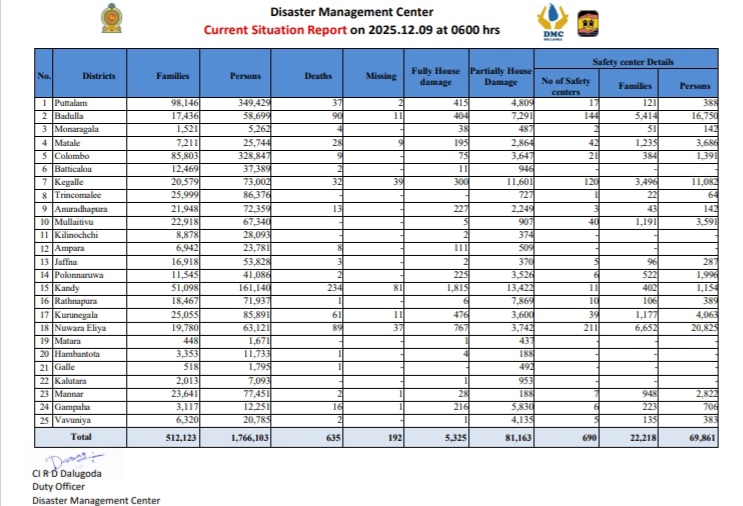
-
News7 days ago
Lunuwila tragedy not caused by those videoing Bell 212: SLAF
-

 News2 days ago
News2 days agoOver 35,000 drug offenders nabbed in 36 days
-

 News6 days ago
News6 days agoLevel III landslide early warning continue to be in force in the districts of Kandy, Kegalle, Kurunegala and Matale
-

 Business4 days ago
Business4 days agoLOLC Finance Factoring powers business growth
-

 News4 days ago
News4 days agoCPC delegation meets JVP for talks on disaster response
-

 News4 days ago
News4 days agoA 6th Year Accolade: The Eternal Opulence of My Fair Lady
-

 News2 days ago
News2 days agoRising water level in Malwathu Oya triggers alert in Thanthirimale
-

 Midweek Review7 days ago
Midweek Review7 days agoHouse erupts over Met Chief’s 12 Nov unheeded warning about cyclone Ditwah


